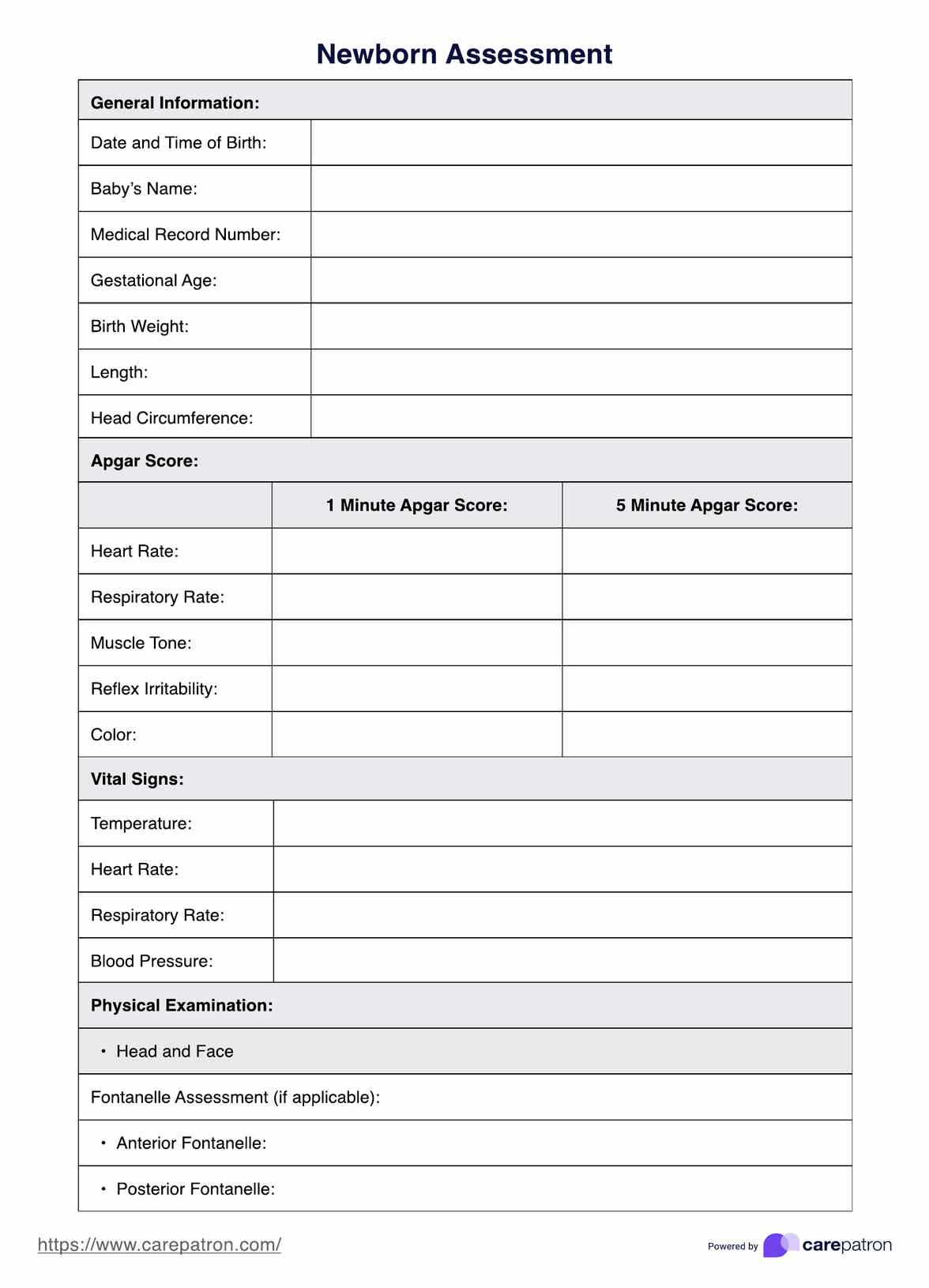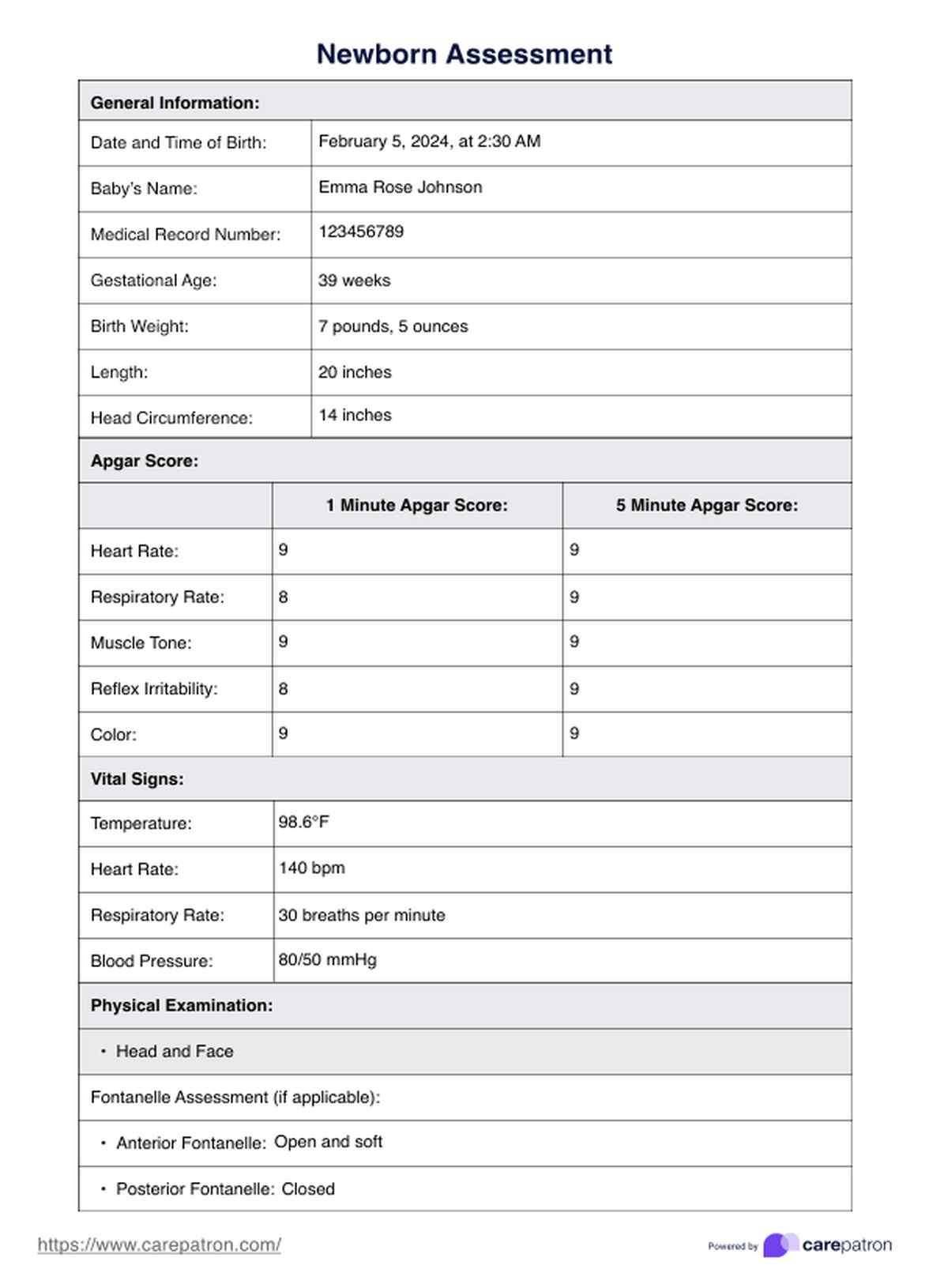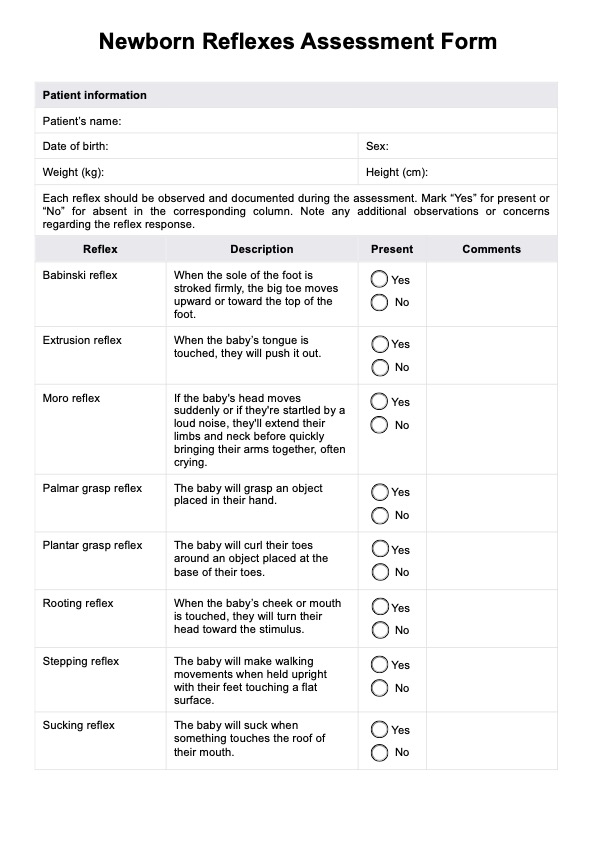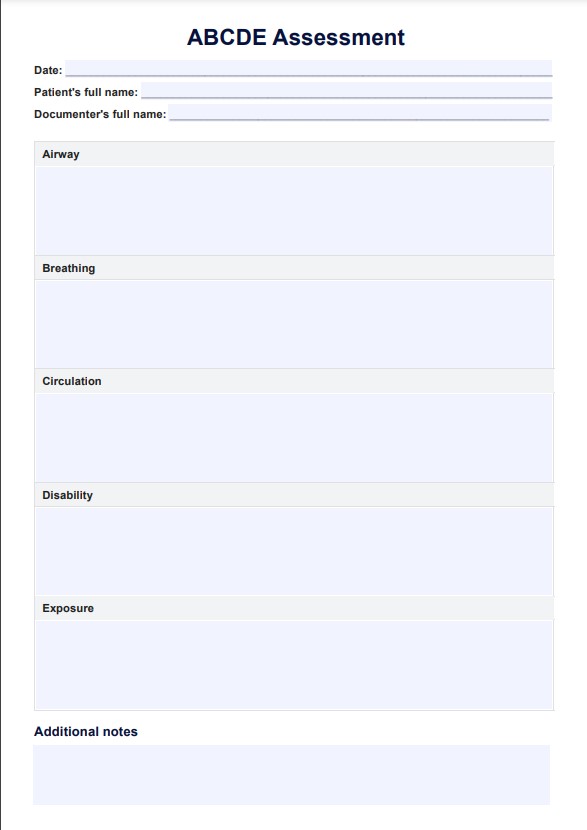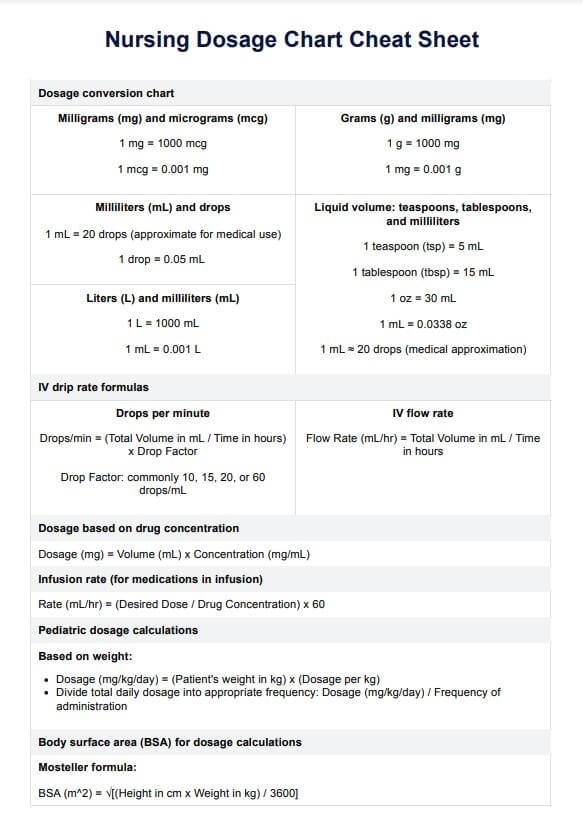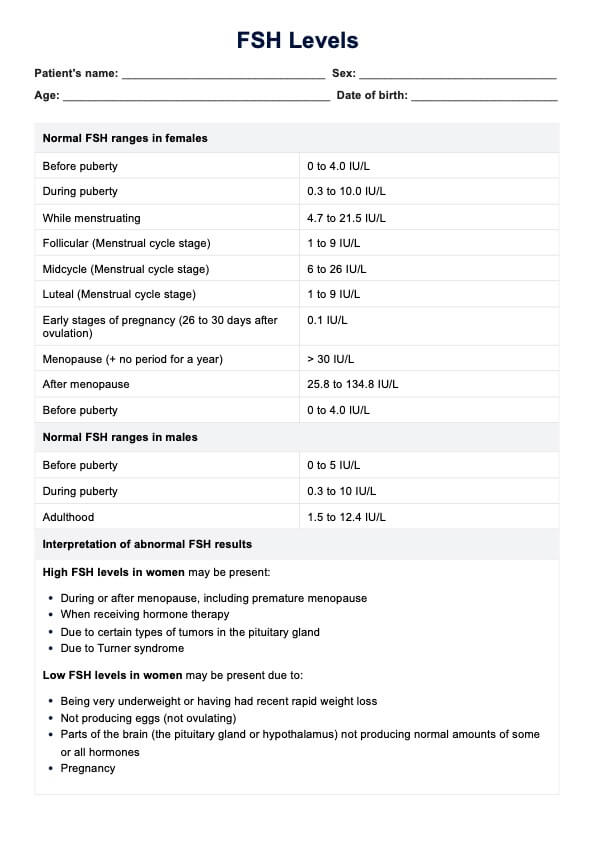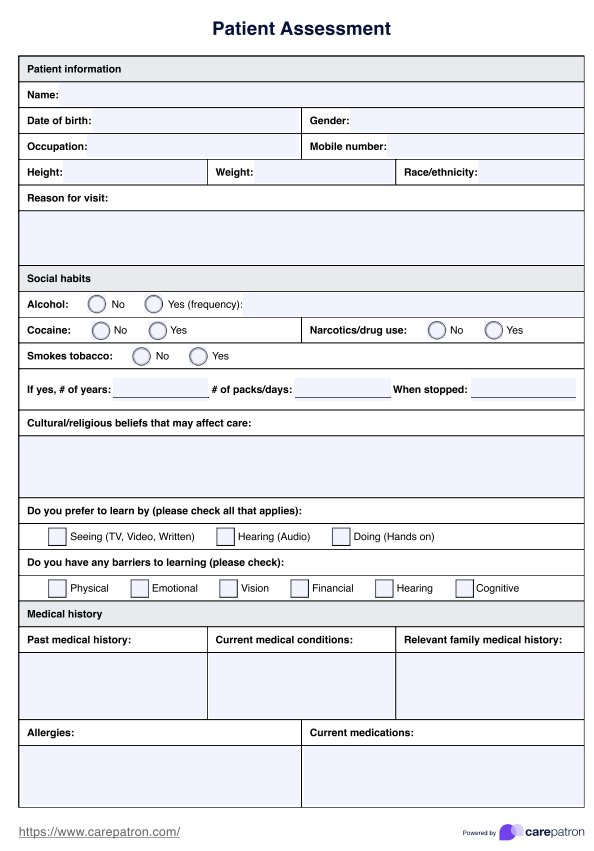Newborn Assessment
Learn about newborn assessments and download Carepatron's free PDF example to thoroughly assess a newborn baby's health and well-being.


What are the assessments for newborn babies?
Newborn assessments play a crucial role in evaluating the health and development of a baby in the early moments of life. These assessments, conducted by healthcare professionals, aim to gather valuable information about the baby's overall health, growth, and potential risks.
Newborn Assessment Template
Newborn Assessment Example
Apgar scoring
Named after Dr. Virginia Apgar, an American anesthetist who developed it in the 1950s, the Apgar score is a quick and effective assessment tool used to evaluate the overall well-being of newborn babies in the crucial moments following birth.
The Apgar score is conducted at one minute and five minutes after birth, providing healthcare professionals with valuable insights into the baby's immediate health status. This scoring system encompasses five key parameters: appearance (skin color), pulse (heart rate), grimace response (reflexes), activity (muscle tone), and respiratory effort. Each parameter is assigned a score between 0 and 2, and the cumulative score determines the overall assessment.
Apgar scoring is crucial for premature babies, as their gestational age and birth weight can influence the results. It serves as an initial assessment tool, guiding healthcare providers in determining if further medical attention or a complete physical exam is necessary.
Birth weight
Birth weight is a critical parameter in the comprehensive assessment of newborn babies, providing valuable insights into their overall health and well-being. This aspect of newborn assessment holds particular significance for premature infants, as their birth weight often correlates with their gestational age and potential health challenges.
The baby's weight at birth is a key indicator of their growth and development in the womb. It serves as a crucial component in assessing the baby's overall health and well-being, influencing decisions regarding their care and any necessary interventions.
Additionally, weighing babies at birth is a routine part of the newborn assessment process. It helps healthcare professionals identify any deviations from the expected weight range, which may indicate potential health concerns or the need for additional monitoring.
Birth weight is often assessed in conjunction with a complete physical exam, including an evaluation of vital signs such as heart rate, respiratory rate, and temperature. This comprehensive approach ensures a thorough understanding of the newborn's overall health status.
Measurements
Newborn assessment through measurements is a meticulous process that involves evaluating various aspects of a baby's physical development. This comprehensive approach, often integrated into the overall physical examination, provides healthcare professionals with valuable information about the baby's growth, potential risks, and overall well-being.
One fundamental aspect of newborn assessment is measuring the baby's length. This involves determining the distance from the top of the baby's head to the heel. Length measurement is essential in assessing the baby's overall growth and identifying any abnormalities or concerns.
Next, measuring the baby's head circumference is crucial for monitoring brain growth and development. An abnormal head circumference may indicate certain conditions or require further investigation.
Weighing the baby is a routine practice in newborn assessment. It allows healthcare providers to gauge the baby's nutritional status and overall growth. This measurement is particularly significant for premature babies or very small infants whose birth weight may influence their health and development.
In addition to body measurements, assessing vital signs such as heart rate, respiratory rate, and temperature is integral to newborn examination. These vital signs offer insights into the baby's cardiovascular and respiratory systems, ensuring a holistic understanding of their overall health.
For premature or very small babies, healthcare providers pay special attention to these measurements as they can indicate their ability to thrive outside the womb. Conversely, very large babies may raise concerns about potential delivery complications and long-term health implications.
Importance of assessments for newborn babies
Conducting thorough assessments for newborn babies is of paramount importance in ensuring their health and well-being. These assessments play a crucial role in evaluating various aspects, including the baby's gestational age, birth weight, and potential risks associated with premature birth.
1. Understanding gestational age
Assessments provide healthcare professionals with essential information about the baby's gestational age, allowing them to tailor care plans based on developmental milestones. Premature babies, born before completing a full-term pregnancy, may require specialized attention due to their unique needs and potential vulnerabilities.
2. Monitoring birth weight
The baby's birth weight is a crucial indicator of its nutritional status and overall growth. Assessments help identify very small babies who may be at a higher risk of complications or birth defects, prompting timely interventions to support their healthy development.
3. Evaluating physical well-being
Assessments contribute to an in-depth understanding of the newborn's physical well-being. Through careful examination of parameters like the baby's skull, healthcare professionals can detect abnormalities early on, ensuring prompt intervention and reducing the risk of long-term health issues.
4. Identifying potential risks
For premature babies, assessments are instrumental in identifying potential risks associated with their early arrival. These assessments aid in the early detection of birth defects or developmental challenges, enabling healthcare providers to implement appropriate interventions and support measures.
Commonly asked questions
To convert grams to pounds and ounces for birth weight, divide the weight in grams by 453.592. The whole number represents pounds, and the remainder represents ounces.
The five measures in a neonate assessment are Apgar score, physical examination, measurements (length, head circumference, weight, chest circumference), vital signs (heart rate, respiratory rate, temperature), and complete neurological examination.
Normal findings in a newborn baby include a Apgar score of 7 or above, steady vital signs within the normal range, appropriate weight, length, and head circumference measurements, responsive reflexes, and clear skin with no visible abnormalities.


